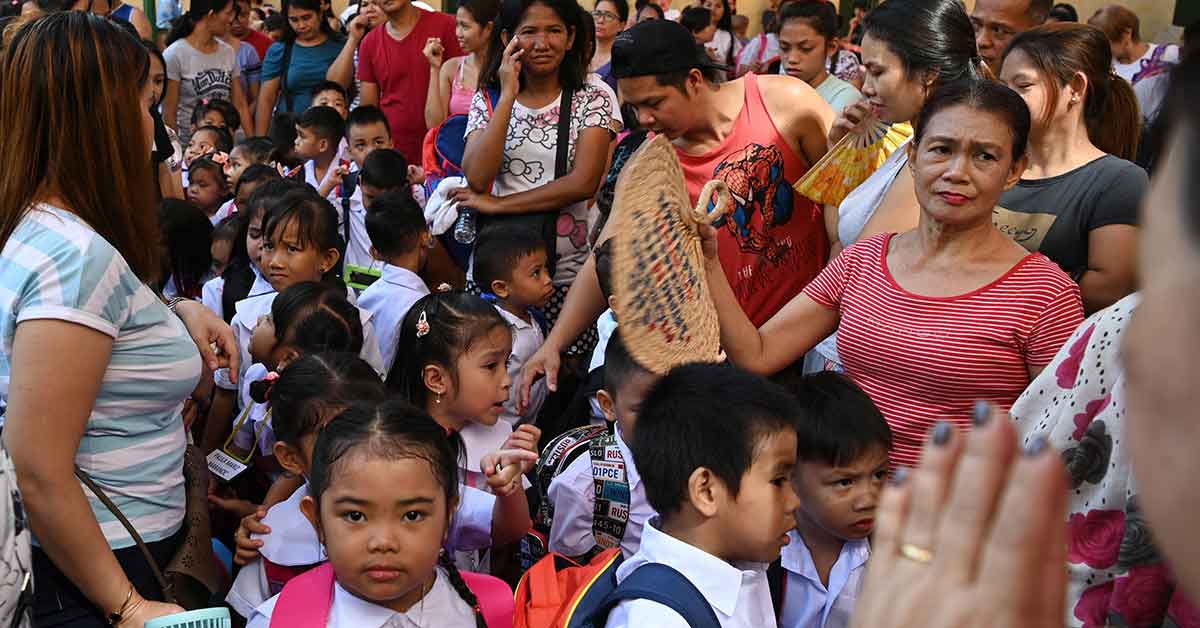One of the most affected segments of our society that has been shaken by the global pandemic caused by the novel coronavirus, SARS CoV-2, is the education sector. The COVID-19 pandemic has affected the lives of all learners in the Philippines since March. There have been many enthralling stories of learners being distressed by the spread of the deadly virus as schools across the country were closed. This is the first pandemic to have had a profound impact on education not only in the Philippines but across the world.
Countries like South Korea and France have been forced to close their schools shortly after they re-opened due to spikes in coronavirus cases. In the Philippines, while the government and health officials are trying to flatten the epidemiological curve of the deadly virus, the Department of Education (DepEd) is working hard to transition the modality of teaching from conventional “face-to-face” learning, or the traditional "brick-and-mortar schools” to so-called “blended learning.” At the moment, the DepEd is absorbed in its month-long “remote enrolment process”, which started on 1 June, 2020.
“Remote enrolment” means that parents or guardians can enrol their children through alternative ways, i.e. via phone calls, text messaging or online submissions to avoid face to face interactions. This is to minimise the risks of possible transmissions of the deadly virus. The DepEd was given the go signal by President Duterte and the Interagency Task Force (IATF) on Emerging Infectious Diseases to proceed with the opening of classes on 24 August, 2020, as long as the health, safety, and welfare of learners and educators are protected against the COVID-19 virus. This takes precedence as there is no available vaccine yet, and the novel coronavirus is still wreaking havoc across the country.
During his presentation to the President on the opening of classes on 29 May, Secretary Leonor “Liling” Briones of the DepEd assured President Duterte and the public in general that, “there will be no face to face classes and sessions until we are assured of the safety of our children and our teachers. However, we also believe, Mr. President, that we can provide learning opportunities to our students without necessarily requiring them to go to school. And this we can do through what is described as “blended and distant learning.”
According to Sec. Briones, “blended learning” is not as novel as the novel coronavirus in the Philippines. Such a form of learning is already offered in some schools and universities in the country.
"Blended learning" or “hybrid learning” from the standpoint of the DepEd is a fusion of “online distant learning” and “in-person” delivery of printed materials to the homes of the learners through the barangays (villages) for those who don’t have internet access and interactive facilities in the comfort of their homes. In localities where this is not possible, the DepEd will use television and radio-based instructions. Radios and televisions across the country will be used to broadcast lessons, materials and instructions to those who don't have access to a computer or the internet.
The DepEd is optimistic and confident that “distant online learning” will work given that more than 80 percent or 700,000 of their teachers have laptops and desktops in their homes. This figure is based on a survey conducted by the DepEd. Likewise, the various approaches of blended learning will be acclimatised to the context of the various localities where they are applied. Thus, “blended learning” is “differentiated instruction”, where there’s a combination of online and in-person delivery. The online portion effectively replaces some of the face-to-face contact time rather than supplementing it.
Challenges To Blended Learning
The intention of the DepEd is to continuously extend quality education to learners in the country by employing “blended learning” despite the obvious threat of COVID-19 is not only understandable but commendable. For what it’s worth, educating the youth even during a pandemic is still important. However, there are certain realities that the DepEd needs to look at closely as it prepares for the roll-out of its blended learning program.
Many marginalised, poverty-stricken, and vulnerable children in the country will be at a disadvantage. The possible increase in payment charges for internet subscriptions which is a cost to both, learners and teachers is another reality. To note, internet services in the Philippines are not only slow but quite expensive compared to other countries in the region.

The information communication technology (ICT) infrastructure in the Philippines is also not yet fittingly developed though it is thriving. There is unequal and asymmetrical access to ICT amenities across the different socio-economic classes in the country. Many areas of the country lack internet access and those that have access either suffer from poor speeds or a lack of bandwidth. Likewise, buying the right technology – software and hardware – for any “blended learning” program will be costly to both, the government (DepEd) and parents.
Although in the long-run such investments will pay-off given that it will to some extent contribute to the modernisation and digitalisation of the country’s education system. But at the outset, both the government and parents have to initially cover the costs before they can reap the benefits. The issue of "security and hacking" is another matter that needs to be mulled over.
The more the government (DepEd) ventures into online platforms for the delivery of public goods and services like education, the more it exposes itself to online security risks such as hacking, identity theft, fraud, forgery, data leakage, and the like. The issue of personal data and privacy protection is another matter that the DepEd has to consider. The other imminent challenges the DepEd may encounter when implementing its “blended learning” program include (a) developing technological capacity, allocating financial resources, and adjusting institutional contexts accordingly; and (b) changing the mindsets and behaviour of educators and learners.
Among the possible challenges facing teachers include having to grapple with an increased cognitive load, and a vertical and high-ceilinged learning curve, especially for teachers who are not acquainted with blended learning. Teachers who are not as adjusted and familiar with the dynamics of technology, have to upgrade their aptitude and literacy quickly. This could be more challenging for these teachers than their students.
Teachers must acquire a certain level of IT competency and proficiency needed for distant online learning to work effectively. Otherwise, this will become a barrier that may hamper the success and effectiveness of online learning. Furthermore, to synchronise, compare, and measure the speed and rate of progress of learners in online courses as opposed to those who are learning offline might be a tough undertaking for teachers. Hence, there will be a significant amount of extra work involved for teachers as they prepare themselves for the implementation of the “blended learning” program as schools re-open in August.
Learners may experience cognitive overload as teachers may overdeliver content and activities. The lack of direct supervision by teachers and the varying levels of ability among learners to comprehend and process lessons being delivered to them may result in poorer outcomes. Moreover, while there are learners who will be motivated and adapt to “blended learning” fast, there will also be learners who will not be as interested and enthusiastic. Others may also experience difficulty in transitioning from “face to face” learning to “blended learning.”
One of the likely impacts of blended distant learning is the added weight on parents who will more or less have to cope-up with juggling work, house chores, family matters/affairs, while at the same time assisting if not monitoring their children’s distant online learning. This will be exhausting on the part of parents or guardians, especially those who are economically challenged and can’t afford to hire a tutor to assist their children.
“Blended learning” will also be more problematic and challenging for parents who have a lower level of literacy, less formal education or have never gone to school. How can they possibly guide or even teach their children when they themselves don’t have the required competencies to do so? In distant learning, the ability and capacity of parents to assist their children is crucial for the system to work. This is another reality that the DepEd has to take into consideration as it prepares to roll-out operation “blended learning” when schools re-open in the Philippines on 24 August, 2020.
Conclusion
Education is of great consequence to children for they are the future of the nation. President Duterte echoed this sentiment when he said, “the future of this country depends on how we educate our young people nowadays.”
The DepEd’s aspiration to continue the formal education of the youth through alternative and innovative learning pathways despite the prevalent COVID-19 threat becomes all the more pertinent and relevant. While there are challenges in implementing “blended learning”, the need to educate the young people of the country is not only essential but also imperative.
Taking into consideration all the perceived challenges that “blended learning” may encounter, the support for and cooperation with the DepEd among all possible stakeholders is crucial. In this regard, it is reassuring that President Duterte said, “it is but good that the government is full force in its support to DepEd to fully extend all the necessary assistance for DepEd to carry out blended learning.”
There is no doubt that the DepEd through the active and able leadership of Sec. Briones will ensure that everything will be on-track and in place for “blended learning” to work. Nevertheless, it is also the responsibility of parents and guardians to decide what’s best for their children based on their respective realities. The decision to enrol or not is a voluntary process, and it is in the hands of parents/guardians to decide whether to allow their children to attend formal education this school year (2020-2021) or not.
The perceived shortcomings of blended learning due in part to the country’s third world ICT amenities and infrastructures, and socio-economic challenges, are not at all unsurpassable. The pros will outweigh the cons if there’s strong cooperation among all stakeholders coupled with strong political will on the part of the government and the DepEd.
Related Articles:

